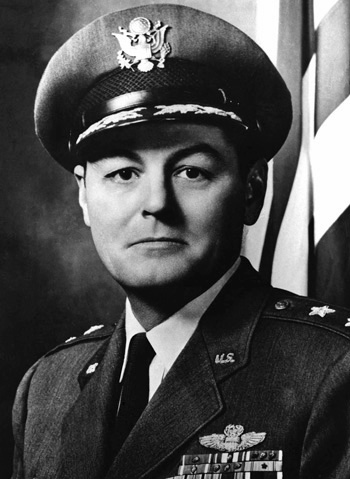
|
Richard H. Carmichael |
 |
|||
| Rank, Service | ||||
Major General O-8, U.S. Air Force |
||||
| Veteran of: | ||||
|
||||
| Tribute: | ||||
Richard Carmichael was born on April 11, 1913, in Hillsboro, Texas. He enlisted in the Texas National Guard on July 6, 1928, and was honorably discharged on July 5, 1932, in order to enter the U.S. Military Academy at West Point. Carmichael graduated with a commission as a 2d Lt of Field Artillery on June 12, 1932, and immediately began flight training in the Army Air Corps, receiving his pilot wings at Kelly Field, Texas, on October 1, 1937. His first assignment was as a pilot with the 18th and then the 6th Pursuit Squadrons at Schofield Barracks, Hawaii, from November 1937 to May 1939, followed by service as a recruit instructor at Hamilton Field, California, from May 1939 to March 1940. His next assignment was as a pilot and later executive officer and then commanding officer of the 9th Bomb Squadron, first at Hamilton Field, and later at Fort Douglas, Utah, from March 1940 to December 1941. Col Carmichael took command of the 88th Reconnaissance Squadron of the 7th Bomb Group in December 1941, and landed at Hickam Field, Hawaii, with his squadron of B-17 Flying Fortress bombers during the Japanese attack on December 7, 1941. He next served as commander of the 19th Bomb Group in Australia from February 1942 to January 1943, during which time he flew combat missions in the South Pacific Area. His next assignment was as executive assistant to Gen Hap Arnold in Washington, D.C., from January to June 1943, and then as commander of the 462nd Bomb Group at Smokey Hill Army Airfield, Kansas, from July 1943 to April 1944, and then deployed to India from April 1944 until he was shot down over Japan and taken as a Prisoner of War on August 20, 1944. Col Carmichael was repatriated on August 29, 1945, and was briefly hospitalized for his injuries in San Antonio, Texas, from August 1945 to February 1946. He served as an admin officer at Wright Field, Ohio, from March to August 1946, and then attended Air Command and Staff School at Maxwell Field, Alabama. After completing the course, he remained at Air University as Chief of the Air Power Employment Branch until June 1949. His next assignment was as commander of the 11th Bomb Group at Carswell AFB, Texas, from June 1949 to March 1950, followed by service as commander of the 98th Bomb Group, first at Spokane AFB, Texas, and then in Japan, from April 1950 to April 1951, during which time he flew combat missions during the Korean War. Gen Carmichael next served as commander of the 14th Air Division at Travis AFB, California, from April 1951 to May 1953, followed by service in Japan as commander of the Far East Air Forces Bomber Command from May 1953 to March 1954, which included bombing missions during the closing months of the Korean War. He served as commander of the 21st Air Division at Forbes AFB, Kansas, from March to April 1954, and then served as deputy director and then director of Personnel Procurement and Training at Headquarters U.S. Air Force in the Pentagon from April 1954 to July 1958. Gen Carmichael's final assignment was as commandant of the Air Command and Staff College with Air University at Maxwell AFB from July 1958 until he was medically retired from the Air Force on January 19, 1961. Richard Carmichael died on April 14, 1983, and was buried at Arlington National Cemetery. |
||||
|
||||

